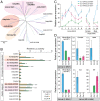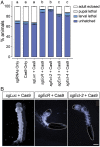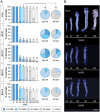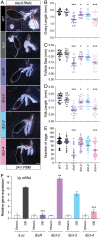Essential functions of mosquito ecdysone importers in development and reproduction
- PMID: 35696563
- PMCID: PMC9231622
- DOI: 10.1073/pnas.2202932119
Essential functions of mosquito ecdysone importers in development and reproduction
Abstract
The primary insect steroid hormone ecdysone requires a membrane transporter to enter its target cells. Although an organic anion-transporting polypeptide (OATP) named Ecdysone Importer (EcI) serves this role in the fruit fly Drosophila melanogaster and most likely in other arthropod species, this highly conserved transporter is apparently missing in mosquitoes. Here we report three additional OATPs that facilitate cellular incorporation of ecdysone in Drosophila and the yellow fever mosquito Aedes aegypti. These additional ecdysone importers (EcI-2, -3, and -4) are dispensable for development and reproduction in Drosophila, consistent with the predominant role of EcI. In contrast, in Aedes, EcI-2 is indispensable for ecdysone-mediated development, whereas EcI-4 is critical for vitellogenesis induced by ecdysone in adult females. Altogether, our results indicate unique and essential functions of these additional ecdysone importers in mosquito development and reproduction, making them attractive molecular targets for species- and stage-specific control of ecdysone signaling in mosquitoes.
Keywords: Aedes aegypti; Drosophila melanogaster; ecdysone; organic anion-transporting polypeptide (OATP); vitellogenesis.
Conflict of interest statement
The authors declare no competing interest.
Figures





Similar articles
-
Steroid Hormone Entry into the Brain Requires a Membrane Transporter in Drosophila.Curr Biol. 2020 Jan 20;30(2):359-366.e3. doi: 10.1016/j.cub.2019.11.085. Epub 2020 Jan 9. Curr Biol. 2020. PMID: 31928869 Free PMC article.
-
A Membrane Transporter Is Required for Steroid Hormone Uptake in Drosophila.Dev Cell. 2018 Nov 5;47(3):294-305.e7. doi: 10.1016/j.devcel.2018.09.012. Epub 2018 Oct 4. Dev Cell. 2018. PMID: 30293839 Free PMC article.
-
Functional characterization of putative ecdysone transporters in lepidopteran pests.Insect Biochem Mol Biol. 2022 Dec;151:103830. doi: 10.1016/j.ibmb.2022.103830. Epub 2022 Sep 3. Insect Biochem Mol Biol. 2022. PMID: 36064128
-
Ecdysone signaling in adult Drosophila melanogaster.J Insect Physiol. 2012 Mar;58(3):293-302. doi: 10.1016/j.jinsphys.2012.01.013. Epub 2012 Jan 28. J Insect Physiol. 2012. PMID: 22310011 Review.
-
Molecular biology of mosquito vitellogenesis: from basic studies to genetic engineering of antipathogen immunity.Insect Biochem Mol Biol. 2002 Oct;32(10):1275-86. doi: 10.1016/s0965-1748(02)00090-5. Insect Biochem Mol Biol. 2002. PMID: 12225918 Review.
Cited by
-
Early attainment of 20-hydroxyecdysone threshold shapes mosquito sexual dimorphism in developmental timing.Nat Commun. 2025 Jan 18;16(1):821. doi: 10.1038/s41467-025-56224-y. Nat Commun. 2025. PMID: 39827175 Free PMC article.
-
Evolutionary genomics of camouflage innovation in the orchid mantis.Nat Commun. 2023 Aug 10;14(1):4821. doi: 10.1038/s41467-023-40355-1. Nat Commun. 2023. PMID: 37563121 Free PMC article.
-
Steroid hormone regulation of innate immunity in Drosophila melanogaster.PLoS Genet. 2023 Jun 15;19(6):e1010782. doi: 10.1371/journal.pgen.1010782. eCollection 2023 Jun. PLoS Genet. 2023. PMID: 37319172 Free PMC article. Review.
-
Juvenile Hormone and Ecdysteroids Facilitate the Adult Reproduction Through the Methoprene-Tolerant Gene and Ecdysone Receptor Gene in the Female Spodoptera frugiperda.Int J Mol Sci. 2025 Feb 23;26(5):1914. doi: 10.3390/ijms26051914. Int J Mol Sci. 2025. PMID: 40076541 Free PMC article.
References
-
- Yamanaka N., Ecdysteroid signalling in insects—From biosynthesis to gene expression regulation. Adv. Insect Physiol. 60, 1–36 (2021).
-
- Thomas H. E., Stunnenberg H. G., Stewart A. F., Heterodimerization of the Drosophila ecdysone receptor with retinoid X receptor and ultraspiracle. Nature 362, 471–475 (1993). - PubMed
-
- Yao T.-P., Segraves W. A., Oro A. E., McKeown M., Evans R. M., Drosophila ultraspiracle modulates ecdysone receptor function via heterodimer formation. Cell 71, 63–72 (1992). - PubMed
-
- Yao T.-P., et al. , Functional ecdysone receptor is the product of EcR and Ultraspiracle genes. Nature 366, 476–479 (1993). - PubMed
-
- Riddiford L. M., Cherbas P., Truman J. W., Ecdysone receptors and their biological actions. Vitam. Horm. 60, 1–73 (2000). - PubMed
Publication types
MeSH terms
Substances
Grants and funding
LinkOut - more resources
Full Text Sources
Molecular Biology Databases
Research Materials

